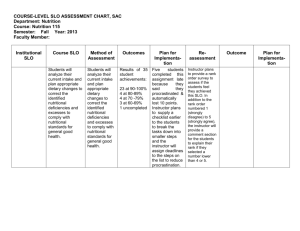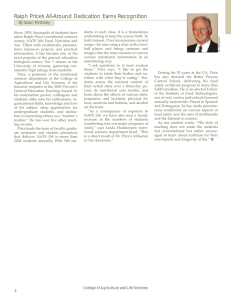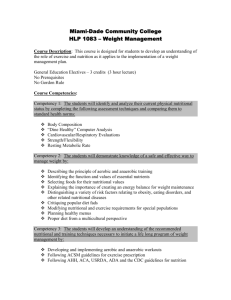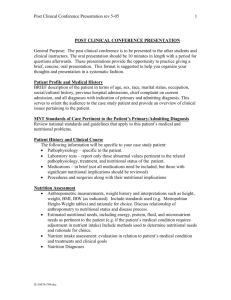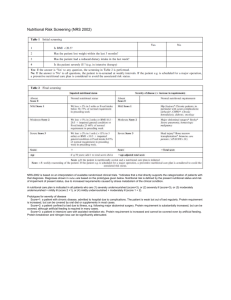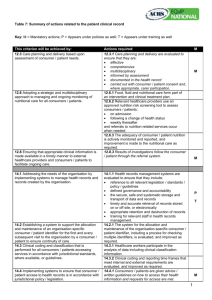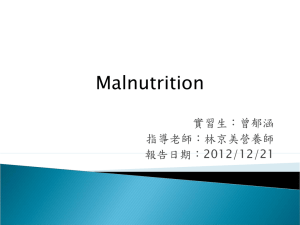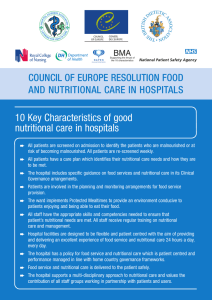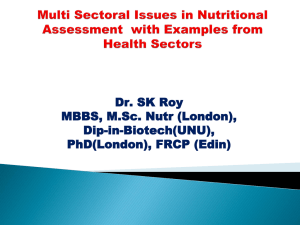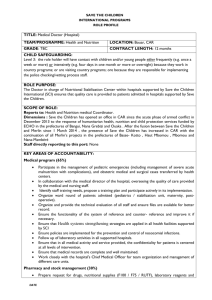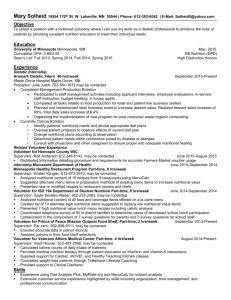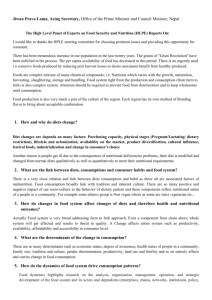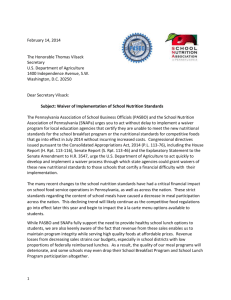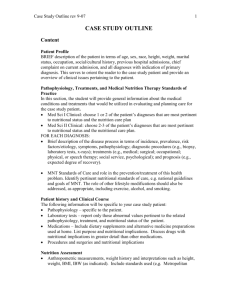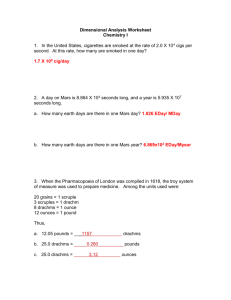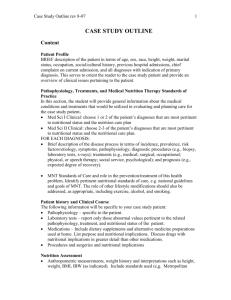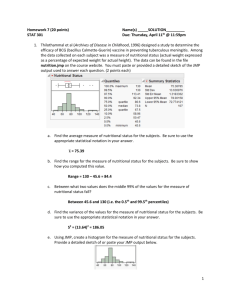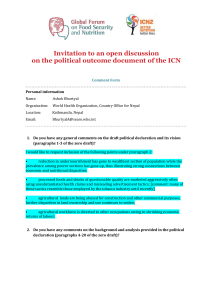Defining Course Learning Outcomes
advertisement
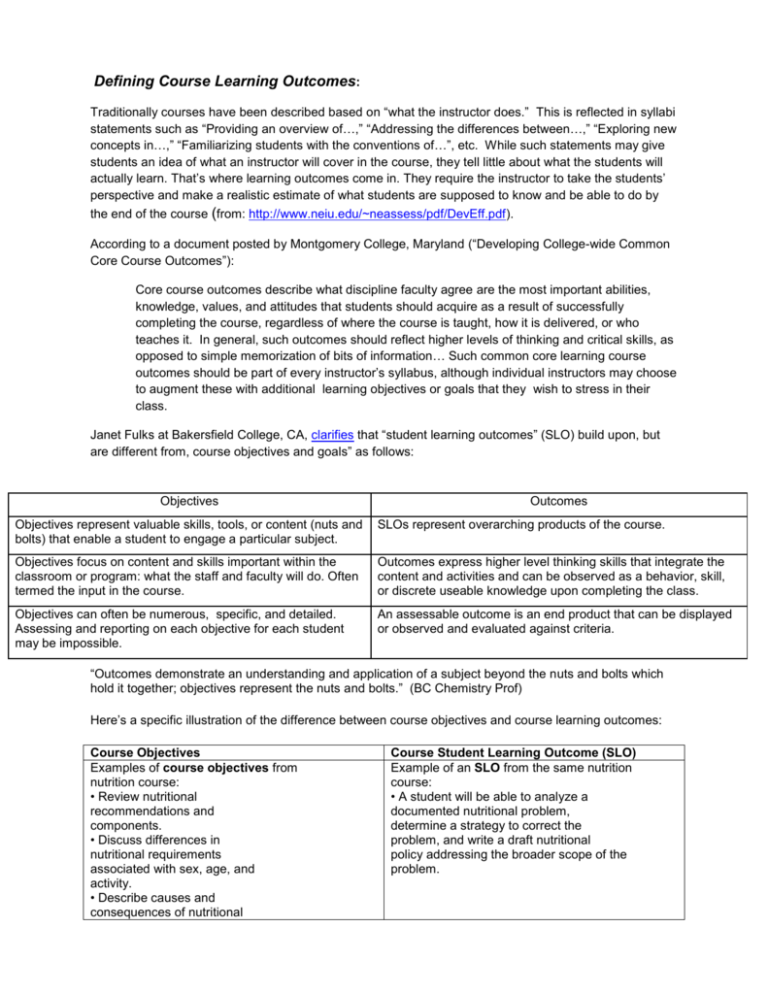
Defining Course Learning Outcomes: Traditionally courses have been described based on “what the instructor does.” This is reflected in syllabi statements such as “Providing an overview of…,” “Addressing the differences between…,” “Exploring new concepts in…,” “Familiarizing students with the conventions of…”, etc. While such statements may give students an idea of what an instructor will cover in the course, they tell little about what the students will actually learn. That’s where learning outcomes come in. They require the instructor to take the students’ perspective and make a realistic estimate of what students are supposed to know and be able to do by the end of the course (from: http://www.neiu.edu/~neassess/pdf/DevEff.pdf). According to a document posted by Montgomery College, Maryland (“Developing College-wide Common Core Course Outcomes”): Core course outcomes describe what discipline faculty agree are the most important abilities, knowledge, values, and attitudes that students should acquire as a result of successfully completing the course, regardless of where the course is taught, how it is delivered, or who teaches it. In general, such outcomes should reflect higher levels of thinking and critical skills, as opposed to simple memorization of bits of information… Such common core learning course outcomes should be part of every instructor’s syllabus, although individual instructors may choose to augment these with additional learning objectives or goals that they wish to stress in their class. Janet Fulks at Bakersfield College, CA, clarifies that “student learning outcomes” (SLO) build upon, but are different from, course objectives and goals” as follows: Objectives Outcomes Objectives represent valuable skills, tools, or content (nuts and bolts) that enable a student to engage a particular subject. SLOs represent overarching products of the course. Objectives focus on content and skills important within the classroom or program: what the staff and faculty will do. Often termed the input in the course. Outcomes express higher level thinking skills that integrate the content and activities and can be observed as a behavior, skill, or discrete useable knowledge upon completing the class. Objectives can often be numerous, specific, and detailed. Assessing and reporting on each objective for each student may be impossible. An assessable outcome is an end product that can be displayed or observed and evaluated against criteria. “Outcomes demonstrate an understanding and application of a subject beyond the nuts and bolts which hold it together; objectives represent the nuts and bolts.” (BC Chemistry Prof) Here’s a specific illustration of the difference between course objectives and course learning outcomes: Course Objectives Examples of course objectives from nutrition course: • Review nutritional recommendations and components. • Discuss differences in nutritional requirements associated with sex, age, and activity. • Describe causes and consequences of nutritional Course Student Learning Outcome (SLO) Example of an SLO from the same nutrition course: • A student will be able to analyze a documented nutritional problem, determine a strategy to correct the problem, and write a draft nutritional policy addressing the broader scope of the problem. problems. • Explain complications of underlying physiologic conditions (e.g., diabetes & mal-absorption). • Identify key factors involved in correcting nutritional behaviors. • Describe resources and strategies to treat nutritional Writing Common Course Learning Outcomes: A good way to begin the process of developing learning outcomes is for each faculty to take a few minutes and list 5 to 7 most important outcomes achieved by a student in the course. If a set of course objectives already exists, these can be used as a starting point. Course textbooks may also be helpful, as they often describe broad learning outcomes at the start of each chapter or section. Faculty teaching the same course may then share their list of outcomes. Most likely a number of similar outcomes will be on everyone’s list, suggesting that these may the most important of the potential course outcomes. Faculty may agree on a first draft of a list of outcomes, understanding that they will be revised several times before becoming firm (or definitive) and that they will change over time for currency in the discipline and in order to reflect that changing needs and characteristics of students. Note again that learning outcomes should be learning-oriented and student-focused (not coverageoriented) and should focus a course on a few (about 5-7) key purposes that have a realistic chance of being accomplished within a term. Also, they should be general enough to capture important learning, but specific enough to allow for a fair assessment, whose criteria are clearly communicated to students. Finally, a number of institutions use Bloom’s levels of cognitive skills to create student learning outcomes that tap into each of the student ability levels. Below are terms (verbs) that come from Bloom’s Taxonomy which can be used when creating student learning outcomes for a course. Suggested Action Verb List to Use in Each Level of Thinking Skills Knowledge Comprehension Application Analysis Synthesis Evaluation Count Define Describe Draw Identify Labels List Match Name Outlines Point Quote Read Recall Recite Recognize Record Repeat Reproduces Selects State Write Associate Compute Convert Defend Discuss Distinguish Estimate Explain Extend Extrapolate Generalize Give examples Infer Paraphrase Predict Rewrite Summarize Add Apply Calculate Change Classify Complete Compute Demonstrate Discover Divide Examine Graph Interpolate Manipulate Modify Operate Prepare Produce Show Solve Subtract Translate Use Analyze Arrange Breakdown Combine Design Detect Develop Diagram Differentiate Discriminate Illustrate Infer Outline Point out Relate Select Separate Subdivide Utilize Categorize Combine Compile Compose Create Drive Design Devise Explain Generate Group Integrate Modify Order Organize Plan Prescribe Propose Rearrange Reconstruct Related Reorganize Revise Rewrite Summarize Transform Specify Appraise Assess Compare Conclude Contrast Criticize Critique Determine Grade Interpret Judge Justify Measure Rank Rate Support Test Examples of College-Wide Common Core Course Outcomes (from Montgomery College, MD, Developing College-wide Common Core Course Outcomes AR 127: Students will be able to distinguish form and content in 2-dimensional and 3-dimensional works of art. BI 101: Students will be able to explain the role of natural selection in the development of chemical resistance in microbes, viruses, plants and animals. EN 102: Students will be able to apply principles of logical argument and persuasion in their writing. MA 116: Students will be able to demonstrate an understanding of the Central Limit Theorem and sampling distributions and use these to estimate a population parameter. HE 100: Students will be able to analyze and evaluate a nutrition food label and the various components of that food label, and use the information to make healthy food choices. SP 108: Students will find, identify and apply research materials to their speech presentations. Additional resources on the development of course learning outcomes Brigham Young University, here are the “Guidelines for writing learning outcomes: http://learningoutcomes.byu.edu/files/GuidelinesWritingCourseLearningOutcomes.pdf Laney College (Oakland, CA): http://www.laney.peralta.edu/apps/comm.asp?$1=31028 Seattle Central Community College : http://seattlecentral.edu/users/crc/Assessment/IA_Writing_Course_Outcomes.htm

